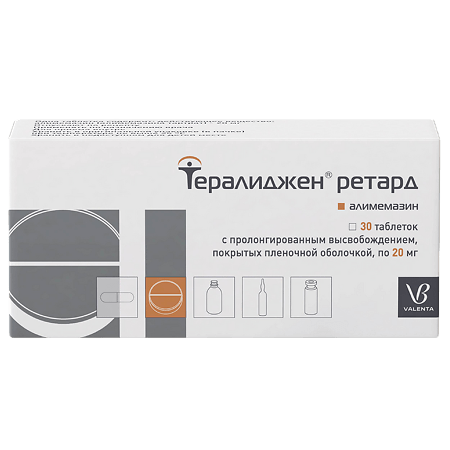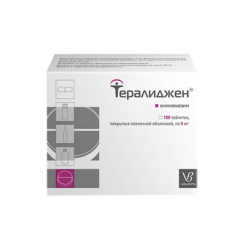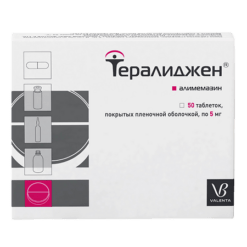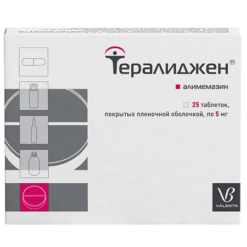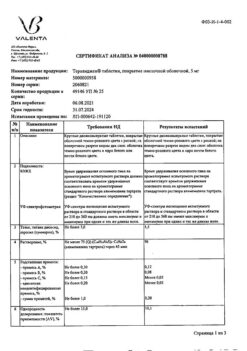No products in the cart.
Theraligen retard, 20 mg 30 pcs
€1.00
Out of stock
(E-mail when Stock is available)
Description Pharmacotherapeutic group: Anxiolytic medicine. Sedative Pharmacodynamics:
ATX: R.06.A.D Phenothiazine derivatives, R.06.A.D.01 Alimemazine
It is a phenothiazine derivative. Alimemazine acts as a mild sedative and anti-anxiety agent, and has a positive effect on senestopathy, obsessive compulsivity, and phobia. It is used for psychosomatic manifestations developing due to neurovegetative disorders, vascular, traumatic and infectious disorders of the central nervous system. Sedative effect promotes normalization of sleep in patients of this category. It has antiemetic and anti-cough activity.
Sedative and anxiolytic effect is caused by blockade of adrenoreceptors of reticular formation of the brain stem. Anti-emetic and vegetative stabilizing effect is caused by blockade of dopamine D2-receptors of trigger zone of the vomiting center. Because of its antihistamine activity, alimemazine is used for allergic diseases, especially of the respiratory tract, and for itching of the skin. Alimemazine is more active in antihistamine and sedative action than diprazine. The antipruritic action is due to its effect on type 1 histamine receptors.
Pharmacokinetics:
It is rapidly and completely absorbed by all routes of administration. The action of alimazine begins 15-20 minutes after administration. The maximum concentration (C max) of alimemazine and the area under the pharmacokinetic curve (AUC) for the drug Teralijen® retard depend linearly on the dose taken. The time of reaching the maximum concentration of alimemazine (Tmax) for the drug Teralijen® retard is 5-6 hours. The binding of alimeazine with plasma proteins is 20-30 %. It is metabolized in the liver. It is excreted by the kidneys – 70-80% as a metabolite (sulfoxide). The elimination half-life (T1/2) of alimazine for the drug Teralizen® retard is 15-17 hours.
.
Indications
Indications
As a sedative (calming), anxiolytic (anti-anxiety) and sleep aid:
– dementia (including dementia due to epilepsy), occurring with manifestations of psychomotor agitation, anxiety affect (as part of combination therapy);
– organic anxiety disorder (in the form of monotherapy or as part of combination therapy);
– mood disorders (affective disorders) – as part of combination therapy;
– generalized anxiety disorder (as part of combination therapy);
– obsessive-compulsive disorder (as part of combination therapy);
– reaction to severe stress and adaptation disorders (acute reaction to stress, post-traumatic stress disorder, unspecified reaction to severe stress, other reactions to severe stress) – as part of combination therapy;
– dissociative (conversion) disorders (as part of combination therapy);
– somatoform disorders (somatization disorder, undifferentiated somatoform disorder, hypochondriacal disorder, somatoform dysfunction of the autonomic nervous system, persistent somatoform pain disorder, unspecified somatoform disorder, other somatoform disorders) – as part of combination therapy for severe anxiety or in case of ineffectiveness of standard therapy;
– unspecified disorder of the autonomic nervous system, other disorders of the autonomic nervous system (as part of combination therapy);
– anorexia nervosa (as part of combination therapy);
– emotionally unstable personality disorder (impulsive and borderline types) – as part of combination therapy;
– hysterical personality disorder, anxious (avoidant, avoidant) personality disorder (as part of combination therapy);
– persistent personality change after experiencing a disaster (as part of combined therapy);
– hyperkinetic behavior disorder (as part of combination therapy);
– behavioral disorder limited to the family (as part of combination therapy when standard therapy is ineffective);
– unsocialized behavior disorder (in the form of monotherapy or as part of combination therapy);
– anxiety, agitation and other symptoms and signs related to the emotional state (as part of combination therapy);
– other neurotic disorders (neurasthenia, unspecified neurotic disorder) – as part of combination therapy;
– insomnia of non-organic etiology (as part of combination therapy when standard therapy is ineffective).
As an antiallergic agent:
– itching, regardless of location and etiology (itching with photocontact dermatitis and solar urticaria, dermatitis, eczema, urticaria, bites or stings from non-venomous insects or other non-venomous arthropods, chicken pox, measles, Hodgkin’s disease, diabetes mellitus, shingles, itching of the posterior passage, vulvar itching, unspecified anogenital itching) as monotherapy or as part of combination therapy;
– unspecified allergy (as monotherapy or as part of combination therapy).
Pharmacological effect
Pharmacological effect
Pharmacotherapeutic group: Anxiolytic agent. Sedative
ATC: R.06.A.D Phenothiazine derivatives, R.06.A.D.01 Alimemazine
Pharmacodynamics:
It is a phenothiazine derivative. Alimemazine acts as a mild sedative and anti-anxiety agent, has a positive effect on senesthopathy, obsession and phobia. It is used for psychosomatic manifestations developing as a result of neurovegetative disorders, vascular, traumatic and infectious disorders of the central nervous system. The sedative effect helps normalize sleep in patients in this category. Has antiemetic and antitussive activity.
The sedative and anxiolytic effect is due to the blockade of adrenergic receptors in the reticular formation of the brain stem. The antiemetic and vegetative stabilizing effect is due to the blockade of dopamine D2 receptors in the trigger zone of the vomiting center. Due to its antihistamine activity, alimemazine is used for allergic diseases, especially the respiratory tract, and for skin itching. Alimemazine is more active in antihistamine and sedative action than diprazine. The antipruritic effect is due to the effect on type 1 histamine receptors.
Pharmacokinetics:
Quickly and completely absorbed by any route of administration. The effect of alimemazine begins 15-20 minutes after administration. The maximum concentration (Cmax) of alimemazine and the area under the pharmacokinetic curve (AUC) for Teraligen® retard depend linearly on the dose taken. The time to reach the maximum concentration of alimemazine (Tmax) for Teraligen® retard is 5-6 hours. The binding of alimemazine to plasma proteins is 20-30%. Metabolized in the liver. Excreted by the kidneys – 70-80% in the form of a metabolite (sulfoxide). The half-life (T1/2) of alimemazine for Teraligen® retard is 15-17 hours.
Special instructions
Special instructions
Alimemazine may mask the ototoxic effect (tinnitus, dizziness) of co-administered drugs.
Alimemazine increases the body’s need for riboflavin.
To prevent distortion of the results of skin prick tests for allergens, the drug should be discontinued 72 hours before allergy testing.
During treatment, false positive results for pregnancy are possible. During treatment you should not drink alcohol.
Impact on the ability to drive vehicles. Wed and fur.:
During treatment with the drug, you should not engage in activities that require increased concentration of attention and speed of psychomotor reactions (driving a car and other vehicles, working with moving mechanisms, working as a dispatcher and operator).
Active ingredient
Active ingredient
Alimemazine
Composition
Composition
One tablet contains:
Active ingredient: alimemazine (alimemazine tartrate) – 20 mg or 40 mg or 60 mg;
Excipients: microcrystalline cellulose (type 101), hypromellose, colloidal silicon dioxide, magnesium stearate;
Shell: Opadry II 85F230124 (for a dosage of 20 mg), Opadry II 85F230060 (for a dosage of 40 mg), Opadry II 85F265071 (for a dosage of 60 mg): partially hydrolyzed polyvinyl alcohol, titanium dioxide E 171, macrogol-3350, talc, iron dye yellow oxide E 172, iron dye red oxide E 172.
Pregnancy
Pregnancy
The use of alimemazine is contraindicated during pregnancy and breastfeeding. If pregnancy occurs during treatment, the drug should be discontinued. If it is necessary to use the drug during lactation, breastfeeding should be stopped.
Contraindications
Contraindications
– Hypersensitivity to the components of the drug;
– angle-closure glaucoma;
– prostatic hyperplasia;
– severe liver and/or kidney failure;
– parkinsonism;
– myasthenia;
– Reye’s syndrome;
– simultaneous use of monoamine oxidase inhibitors (MAO);
– pregnancy;
– lactation period;
– children under 18 years of age (for this dosage form).
With caution:
The drug should be used with caution in case of alcoholism if there is a history of complications when using phenothiazine drugs; with obstruction of the bladder neck; predisposition to urinary retention; for epilepsy; open-angle glaucoma; jaundice; suppression of bone marrow function; arterial hypotension.
Side Effects
Side Effects
Side effects are extremely rare and mild.
From the nervous system: drowsiness, lethargy, fatigue (occur mainly in the first days of use and rarely require discontinuation of the drug), paradoxical reaction (restlessness, agitation, nightmares, irritability), confusion, extrapyramidal disorders (hypokinesia, akathisia, tremor).
From the senses: blurred visual perception (accommodation paresis), noise or ringing in the ears.
From the cardiovascular system: dizziness, decreased blood pressure (BP), tachycardia.
From the digestive system: dryness of the oral mucosa, atony of the gastrointestinal tract, constipation, loss of appetite.
From the respiratory system: dryness in the nose, pharynx, increased viscosity of bronchial secretions.
From the urinary system: bladder atony, urinary retention.
Other: allergic reactions, inhibition of bone marrow hematopoiesis, increased sweating, muscle relaxation, photosensitivity.
Interaction
Interaction
Alimemazine enhances the effects of narcotic analgesics, hypnotics, anxiolytic (tranquilizers) and antipsychotic (neuroleptics) drugs (drugs), as well as drugs for general anesthesia, m-anticholinergic drugs and antihypertensive drugs (dose adjustment required). Tricyclic antidepressants and anticholinergic drugs enhance the m-anticholinergic activity of alimemazine. With the simultaneous use of alimemazine with ethanol, increased depression of the central nervous system is possible. Alimemazine weakens the effect of phenamine derivatives, m-cholinomimetics, ephedrine, guanethidine, levodopa, dopamine.
When alimemazine is used together with antiepileptic drugs and barbiturates, the threshold for convulsive activity decreases (dose adjustment is required).
When alimemazine is used together with beta-blockers, a pronounced decrease in blood pressure and arrhythmias are possible.
Alimemazine weakens the effect of bromocriptine. With simultaneous use in nursing mothers, an increase in the concentration of prolactin in the blood serum is possible.
With the simultaneous use of alimemazine and MAO inhibitors (simultaneous use is not recommended) and alimemazine and phenothiazine derivatives, the risk of arterial hypotension and extrapyramidal disorders increases.
With the simultaneous use of alimemazine with drugs that depress bone marrow hematopoiesis, the risk of myelosuppression increases.
The combined use of phenothiazine derivatives (which includes alimemazine) with hepatotoxic drugs can enhance the manifestations of hepatotoxicity of the latter.
Overdose
Overdose
Symptoms: increased manifestations of the described side effects, with the exception of allergic reactions.
Treatment: drug withdrawal, symptomatic therapy.
Storage conditions
Storage conditions
In the original packaging (in a pack) at a temperature not exceeding 25 °C. Keep out of the reach of children.
Shelf life
Shelf life
3 years.
Do not use after the expiration date stated on the package.
Manufacturer
Manufacturer
Valenta Pharm JSC, Russia
Additional information
| Shelf life | 3 years. Do not use after the expiration date printed on the package. |
|---|---|
| Conditions of storage | In the original package (in the package) at a temperature not exceeding 25 °С. Keep out of reach of children. |
| Manufacturer | Valenta Farm, Russia |
| Medication form | sustained release tablets |
| Brand | Valenta Farm |
Other forms…
Related products
Buy Theraligen retard, 20 mg 30 pcs with delivery to USA, UK, Europe and over 120 other countries.

